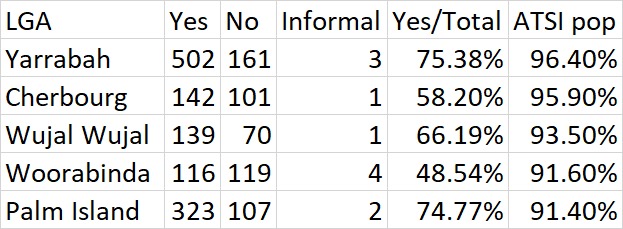Australia’s voice to parliament Polling catchments where Indigenous Australians form more than 50% of the population voted on average 63% in favour of the voice
Australia’s voice to parliament Polling catchments where Indigenous Australians form more than 50% of the population voted on average 63% in favour of the voice
You would expect non indigenous votes to track similar patterns to other nearby polling stations. Consider the pretty smooth gradient we see with yes vs no generally.
It’s not unreasonable to expect non indigenous voting to track the 60% no. It would be strange if they didn’t, possible but not really a reasonable assumption.
So in a 50% place with a 60/40 split you might expect somewhere like the (previously indicated) ~80% voting yes. Perhaps a bit lower, but still high support.
Again, this isn’t the only indicator of indigenous support given the earlier polling.
Sure, in casual conversation it’s a reasonable assumption. That doesn’t hold for journalists writing news articles - particularly when it is stated as fact and not clarified. You have to analyse the numbers to realise the headline is hollow.
No that’s literally how statistical inference works. If you think they’ve made an error submit a letter and get them to retract the article.
No it isn’t, there’s a massive gap in the statistics where the inference should be derived from. If you think I’m wrong then explain it, don’t brush it off without actually saying anything meaningful.
How can you infer that an overwhelming portion of one group supported something when all you have is the combined level of support and no statistics on the individual groups, other than a ratio of population size?
It’s an assumption, it’s not labeled as such, that’s bad journalism.
Sometimes assumptions have to be made especially in this case.
The AEC policy is to cast aside your vote so it doesn’t count towards the election - e.g. if you write your name or signature on the ballot paper, it will tossed out when they count the vote. If you take a selfie with your ballot paper showing how you voted, they are also required to discard your vote.
Reliable data on exactly how people voted is not available and cannot ever be available (under current laws)… so, yes, pretty much anything relating to the election is based on assumptions. That doesn’t make them useless. I’m assuming the sun will rise tomorrow morning… I don’t have any proof, but a lack of proof doesn’t make my assumption wrong.
The data they provided is pretty compelling - for example the Wadeye electorate where 92% of the vote was Yes. And by the way, about 90% of that electorate were are indigenous in the 2016 Census (pretty old now, but it likely hasn’t changed much).
What’s also interesting is those communities bucked other major trends in this election:
If indigenous and white people shared the same opinion on the vote, then you’d expect Wadeye to have one of the strongest No votes in the country. But nope - they voted 92% yes.
You mention Wadeye, but the article also says this:
High indigenous population, yet lower than the overall vote for the nation. The article glosses over how many polling regions this covers.
I don’t doubt that the claim is likely true. I just don’t think they’ve done any sort of statistical analysis to actually support their claim. The article just makes a statement, then lists off numbers as if it all lines up. But there are big gaps and strong reasons to doubt the assumption, and yet the article states it as if it is fact.
The style of writing is as if they’re writing an article about an academic paper, but they haven’t actually got an academic paper behind it.
I think you’re misunderstanding the quote (or I’m misunderstanding you). That quote is supporting the same trend indicated in Wadeye. The 31.3% refers to QLD as a whole, not the ATSI dense communities specifically.
You might be right.
I spent way too much time yesterday going through a full seat here in NSW comparing each polling location to the census data for that location, so I’m not going to do that all again for the entirety of QLD.
However, I did have a look at the QLD LGAs with the highest % ATSI populations and got the following results
I think that’ll be the closest sort of data we can get to an idea of the QLD ITAS support for the voice
The person you’re arguing with understands this. They’re not asking in good faith.
Please don’t strawman or insult me. If you can’t have a reasonable discussion then bugger off.
Ironic…
You’ve contributed nothing here.
get them to retract it if you’re so sure.
Yeah, sure, if I call them out for poor journalism standards they’ll just roll over and accept that, because this article totally wasn’t written with that deception in mind.
There’s no statistical analysis here, as you implied, it’s just a bunch of regions with their population size and overall votes. Hell, many of their numbers didn’t even fit the narrative - they had a large majority indigenous population but more No votes, more than the nation overall. It’s just bullshit and hand waving to get you to accept it as true without really thinking about it.
You’re trying to set an impossible to prove boundary so you can claim that you “win” the argument. That’s bollocks. If you don’t have anything meaningful to say here, yourself, then kindly bugger off.